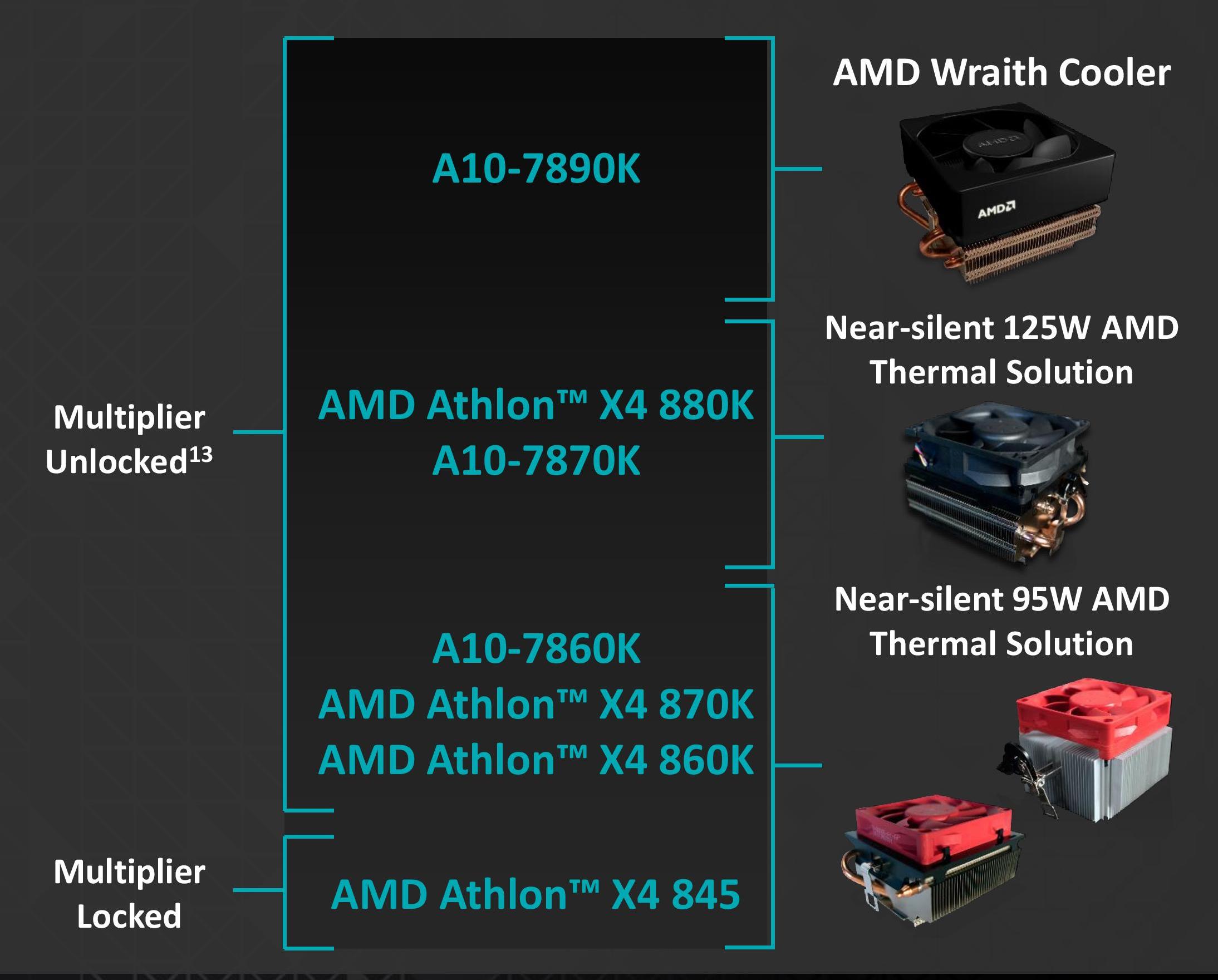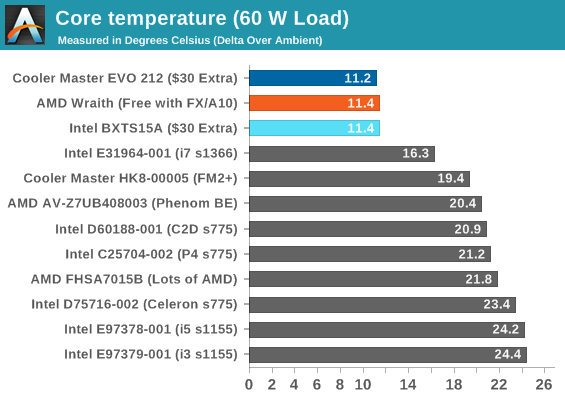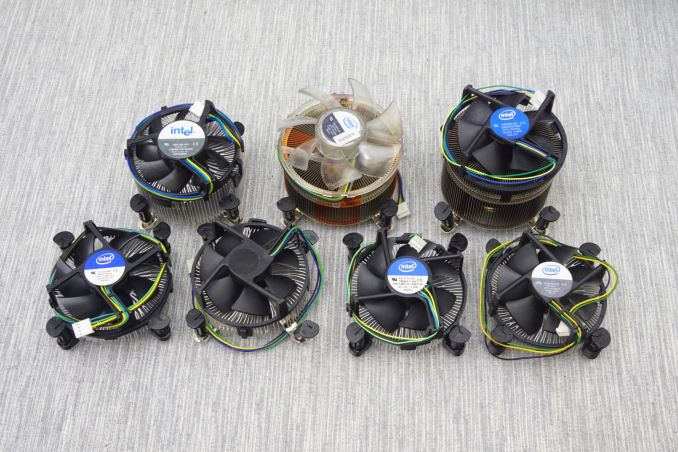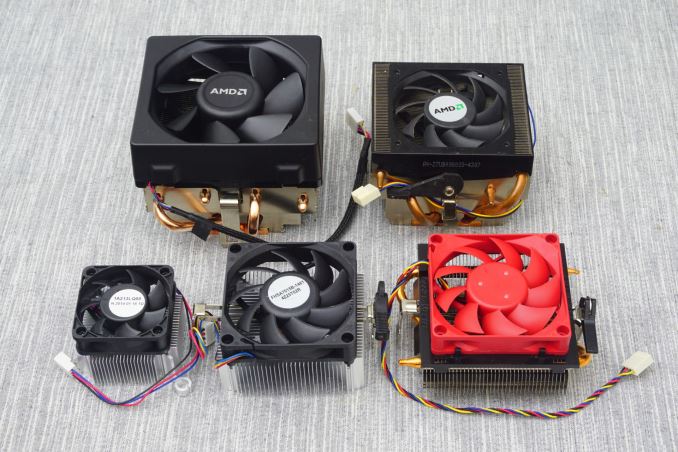Battle of The CPU Stock Coolers! 7x Intel vs 5x AMD, plus an EVO 212
by E. Fylladitakis on July 22, 2016 9:00 AM EST- Posted in
- Cases/Cooling/PSUs
- CPUs
- AMD
- Intel
- Cooler Master
- Cooler
Final Words
In this review we have put together a dozen stock coolers from AMD and Intel, going back through several years, and compared them against a popular off-the-shelf aftermarket cooler. Both AMD and Intel supply stock coolers with most of their processors as a form of 'guaranteed' to work with the processor, but not all solutions are equal, and do not take into account absolute performance or noise. Because AMD has recently launched their high-end Wraith and near-silent stock coolers with their performance processors, we actively went to source a number of these as well as the Cooler Master EVO 212 for an overall comparison.
| Vendor | Cooler | Common Bundle | Core | Fins | Fan (mm) |
Mass (g) |
| Intel | D75716-002 | Socket 775 Celerons | Alu | Alu | ≈80 | 118 |
| C25704-002 | Socket 775, P4 6x0 | Cu | Alu | ≈80 | 132 | |
| E97378-001 | Socket 1155 Intel i5 | Cu | Alu | ≈80 | 146 | |
| E97379-001 | Socket 1155 Intel i3 | Alu | Alu | ≈80 | 92 | |
| D60188-001 | Socket 775, C2D E8x00 | Cu | Alu | ≈80 | 419 | |
| E31964-001 | Socket 1366 i7-X | Cu | Cu/Alu | ≈100 | 435 | |
| BXTS15A | Aftermarket, ≈$30 | Cu | Alu | ≈80 | 362 | |
| AMD | 1A213LQ00 | AMD “Kabini” AM1 | Alu | Alu | 50 | 75 |
| FHSA7015B | Several AMD Lines | Alu | Alu | 70 | 164 | |
| AV-Z7UB408003 | Black Edition Phenom | Alu +2 Cu HP |
Alu | 70 | 374 | |
| Wraith (125W) | AMD FX-8370 AMD A10-7890K |
Cu +4 Cu HP |
Alu | 90 | 304 | |
| Cooler Master | HK8-00005 | AMD FM2+ “Godavari” | Alu | Alu | 70 | 125 |
| EVO 212 | Aftermarket, ≈$30 | Cu +4 Cu HP |
Alu | 120 | 436 |
Intel’s line of stock CPU coolers seem to have been designed to have characteristics agnostic to the requirements of the specific socket it was bundled with. The main difference between the coolers ends up being the noise that the cooler generates. For example, both of the 1155 coolers had similar absolute thermal resistance, but the copper core E97378 is significantly quieter. As one might expect, the only cooler that was an exception to that rule was the one bundled with a $1000 CPU (E31964-001). However, that does not mean that the coolers of cheaper CPUs will perform worse or necessarily be louder overall.
Cheap low power CPUs also have lower thermal losses than the high end models based on similar technology, meaning that an 'inferior' heatsink will also likely have a lower thermal load to deal with. The main difference will be discernable only when the cooler is idling, as the copper core coolers can lower the speed of their fans to nearly inaudible levels. This is arguably the best takeaway message for stock coolers: copper cores help with noise rather than absolute thermal resistance.
For AMD's coolers, there is a clear dichotomy in their cooling range. The high-end parts, particularly those at 95W and above (and the A10-7860K), get the newest and best coolers.

AMD's Cooler Lineup, with FX-8370 and FX-8350 also in the Wraith section
Most of their other CPUs come with the FHSA7015B, a cooler with mediocre overall performance that just gets the job done. Certain top tier models, such as the Godavari core FM2+ CPUs, come with advanced models that do offer higher overall performance and lower noise levels. The performance of these coolers may not be on par with mainstream tower coolers comparable to the Cooler Master EVO 212, but it is an upgrade comparable to buying an entry-level $15-20 tower aftermarket cooler and meeting the EVO half-way, in a sense. Only the latest 125W Wraith cooler is an exception, greatly outpacing even the Cooler Master HK8-00005 and AMD AV-Z7UB408003, coolers that were or are being supplied with other top tier CPUs.
Conclusion: AMD's Wraith is a Great Free $30 Upgrade
It's clear from the market that AMD is taking a broader interest in coolers recently, whereas Intel has taken a different direction with the new Skylake-K CPUs being sold without stock coolers. It creates an interesting platform where a good cooler might add to the cost of a processor, whereas the high performing CPUs remove their stock coolers to become more price competitive (even if you have to spend another $30 to get a cooler anyway).
But naturally, our conclusion is going to be dominated by the top performers of this roundup - the Intel BXTS15A, the AMD Wraith and the Cooler Master EVO 212.
AMD is supplying the Wraith for free alongside their top tier CPUs and it proved itself capable of performance comparable to that of a reputable mainstream cooler such as the Cooler Master EVO 212. The Wraith’s high thermal performance can be attributed to the strong 90 mm fan and heatpiped design. This saves the average user from spending a significant monetary sum for a good, silent cooler, as the Wraith is more than enough for everyday use and even for reasonable overclocking. For those that are interested, the AMD side lights up when powered as well.


Intel supplies the BXTS15A as an aftermarket cooler, an upgrade over the stock coolers supplied alongside their CPUs. However, it hardly makes sense as an upgrade. There are several better aftermarket CPU coolers better than the BXTS15A with the same price tag, including the Cooler Master EVO 212 that was showcased in this review.
Most of Intel's CPU coolers are rated as 'good enough' for the platforms they target. However, there is no guarantee of long-term stability (note, dust) and we can see that audible performance when pushing a CPU can be excessive. If the BXTS15A was being supplied alongside a CPU then it could prevent some users from upgrading to better coolers, or it could be a viable option if it was selling for less than $20, but has little to no market value as a standalone product at such a retail price. If there are no space constraints or other mechanical issues (mounting security/strength, portability, etc.), then the recommendation is that a user bypasses the BXTS15A and moves straight on to something like the Cooler Master EVO 212 or other comparable aftermarket cooler.
A side note about noise:
It is rather ironic that both AMD and Intel are marketing their best coolers as “quiet” models, as they were among the loudest that we have tested here today when their fans were forced to operate at absolute maximum speed. AMD has stated that the Wraith 'shroud' over the top of the cooler is a few db louder (due to vibrations) than the near-silent variant, but affords additional lighting to show off the system. The catch with both the AMD and Intel solutions is that both of these coolers will actually be quiet when they replace the louder stock coolers that CPUs usually ship with, especially the smaller heatsinks of the cheaper models, although the Intel variant is an extra outlay. If the Wraith or the BXTS15A are installed on a stock CPU, their mass is enough to keep the CPU cool without relying much on airflow, allowing the thermal control of the motherboard to keep the fan’s speed (and noise) very low. It comes down to the cost of such a difference.
Cooling performance can change quickly if the CPU is constantly under heavy stress and/or overclocked, as the thermal losses of the CPU multiply under such conditions. Both companies obviously wanted to ensure that their top end coolers can hold the processors cool enough even under such conditions and thus they are using very strong fans that can provide high levels of airflow if needed. Ultimately the best way to increase airflow in these situations is with larger fans that run slower (such as the EVO), but this can be difficult when staying within specifications or having to design basic coolers to a price point without taking a loss.














82 Comments
View All Comments
ZeDestructor - Monday, July 25, 2016 - link
Yes they could, but then you'd be reducing yields, which would drive final price up.pseudoid - Friday, July 22, 2016 - link
Did I miss the part about the SkyLake (LGA 1151) uPs? The Intel boxed Core I7-6700K Skylake uP comes with no cooling fan. I found that the Noctua coolers are a better fit for my needs, especially the iron-clad 3yr. warranty!LordanSS - Friday, July 22, 2016 - link
Thank you for this review.Although I already expected the 212 EVO to pull ahead (it's tough to match it on price/performance), was interesting to see the differences on the other stock ones. And the Wraith came out as a pleasant surprise.
Maybe in the US it's all about Intel and their CPUs, but in other areas of the world, like here in South America, AMD and their APUs are not doing poorly, with very good (local) pricing and decent enough performance for usual Office and light work cases, and people even use them for League of Legends and DotA2, which are very popular games around here, and not too graphics intensive.
zodiacfml - Friday, July 22, 2016 - link
I went to Intel's list of Skylake desktop CPU's and found only two that has around 90W of TDP.The 212 is only 25C above ambient at 150W.
Anything larger or more expensive than the 212 is pretty much overkill for modern CPUs.
wintermute000 - Friday, July 22, 2016 - link
"modern [Intel standard desktop] CPUs"FIFY
Ascaris - Sunday, July 24, 2016 - link
"modern [Intel standard desktop] CPUs at their stock clock and voltage settings"Byte - Saturday, July 23, 2016 - link
The hyper 212 is a bit overrated and dated, but then again i used it to test a bunch of 6700k i had fun delidding with liquid ultra and it kept them cool to 4.6/4.7GHz pretty easy.phylop - Saturday, July 23, 2016 - link
I would love to see you guys post an anthology of coolers throughout the ages. Include comparing how older coolers would perform on modern CPUs and vice versa.Teknobug - Saturday, July 23, 2016 - link
The 212 is probably the best bang per buck for HSF, can't go wrong with it. I also have a TX3 which is nearly as effective as the 212 and about $10 less, however there is one thing you must do if you're going to use it on an Intel system- ditch the flimsy black/white plastic locks and steal the ones from an Intel HSF to replace them with. Once you do that, you got a pretty solid HSF even for decently OC'd CPU's.Zap - Saturday, July 23, 2016 - link
IMO stock coolers are perfectly fine for systems that run stock speeds and aren't intended to sit running torture tests all day.Noisy? Did you enable "smart fan" in BIOS? Is that in normal use or hammering it with Prime95?
Bad temperatures? Did you install it properly? For whatever reason many people can't figure out push pins when they are super simple to use. Is your temperature "comfort level" calibrated for overclocks when you're just building a stock clocked system for family to use? Fact: Your stock clocked CPU does not require low temperatures.